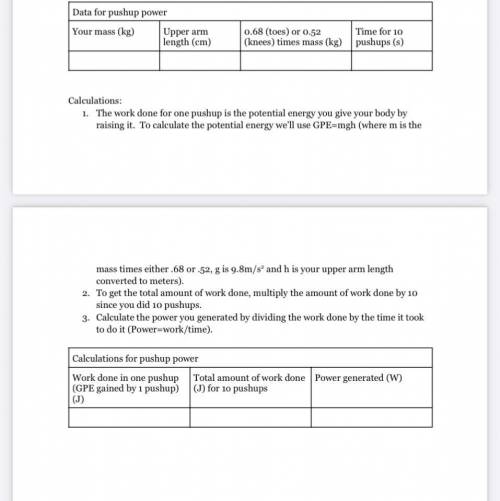Background information:
We know that power is the rate that work is done; what that
really me...

Physics, 30.03.2021 19:00, KKHeffner02
Background information:
We know that power is the rate that work is done; what that
really means is that power tells up how much work is done every
second. To calculate power we just divide the amount of work that
was done by the time it took to do it (Power=work/time). Work is
measured in Joules and time is measured in seconds, we end up with Joules/sec when we calculate power. A Joule/sec is a Watt; we’ll use Watts to measure and compare power.
We also know that the work done on an object is the amount of energy it has gained. For this activity, you’ll be raising your body up as you do pushups which means you’ll be giving your body gravitational potential energy (GPE). To calculate the amount of GPE we multiply mass time gravity times the height raised (GPE=mgh).
What to do (record everything in the table):
1. You need to have a decent estimate of your mass in kilograms: On earth, every
kilogram weighs 2.2 pounds. Either measure your weight on a scale or just
estimate it (in pounds) then divide by 2.2 to get your mass in kilograms.
2. Measure or estimate the length of your upper arm from your elbow to your
shoulder in centimeters...this is how high you raise yourself for every pushup.
3. Decide if you’ll do regular pushups (on your toes) or simpler pushups (knees). If
you are doing regular pushups, multiply your mass by 0.68 because you’ll only be lifting about 68% of your mass each time; if you’re doing simpler pushups, multiply your mass by 0.52 because you’ll only be lifting about 52% of your mass each time.
4. Measure the time it takes for you to do 10 pushups.


Answers: 3
Other questions on the subject: Physics

Physics, 21.06.2019 20:00, izabellehannah7165
Spend time observing or thinking about events that involve matter and energy. which events can you explain? which events can’t you explain?
Answers: 1


Physics, 22.06.2019 10:30, dontcareanyonemo
Avery long solenoid of inner radius 2.75 cm creates an oscillating magnetic field of the form = for this solenoid, =0.00425 t and =319 rad/s. (a)what is the maximum value of the induced electric field at a perpendicular distance 1.45 cm from the axis of the solenoid? (b) what is the maximum value of the inducted electric field at a point 5.85 cm perpendicular from the axis of the solenoid?
Answers: 1

Do you know the correct answer?
Questions in other subjects:



Mathematics, 16.02.2021 01:50

Mathematics, 16.02.2021 01:50

History, 16.02.2021 01:50

Mathematics, 16.02.2021 01:50


English, 16.02.2021 01:50

English, 16.02.2021 01:50

Biology, 16.02.2021 01:50






